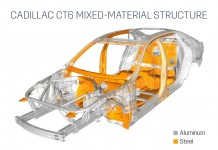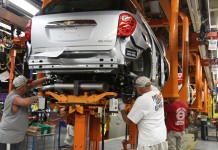NEW YORK: General Motors said it had fully repaid billions of dollars in government loans five years early, prompting its CEO to proclaim the once-crippled automaking giant was making “great progress.”
The White House seized on the fact that GM had reimbursed 8.4 billion dollars to the US and Canadian governments so far ahead of schedule as proof President Barack Obama’s economic rescue plans were working.
Wednesday’s announcement came a year after Obama faced the perilous political choice of either bailing out GM and Chrysler or letting them collapse with dire economic and social consequences.
“GM’s ability to pay back our loans ahead of schedule is a sign that our plan is working and that we’re on the right track,” chief executive officer Ed Whitacre said to cheers from workers at a GM Assembly plant in Kansas.
The new, post-bankruptcy GM made a final 5.8 billion dollar loan payment to the US and Canadian governments Tuesday.
The payments however do not include much higher loans made to the company under its former guise, being slowly wound down through the bankruptcy process.
The US government, which provided about 50 billion dollars in emergency loans, holds a 60.8 percent stake in the new company and 2.1 billion dollars in preferred stock. The Canadian government and a retiree health care trust also hold significant stakes.
The White House, accused by Republicans of a massive takeover of the economy when it decided to prop up GM, greeted the news as proof Obama’s policies were helping haul the US economy out of crisis.
“What a difference a year makes. Just about a year ago, the American auto industry was on the brink of collapse,” said Lawrence Summers, director of Obama’s National Economic Council in a White House blog post.
A Council report said Obama had made a “difficult and unpopular choice to support our economy, the American auto industry and American jobs.”
Treasury Secretary Timothy Geithner hailed the loan repayments as a “positive sign” and said “countless jobs” had been saved.
In Ottawa, Canadian Prime Minister Stephen Harper also said his government had also made the right decisions.
“Not only has GM repaid their loan in full, ahead of schedule, but new shifts have also been created at Canadian auto plants.”
GM has vowed to launch a public stock offering as soon as is practical, perhaps as early as the second half of this year, but it will likely take years for the US government to wind down its massive stake.
“We are able to repay the taxpayers ahead of schedule because we are designing, building and selling the best cars and trucks GM has ever produced,” Whitacre said.
“Yes, we still have a lot of hard work ahead of us even with the repayment of the loan,” Whitacre acknowledged, adding that “we’re making a lot of progress — great progress.”
General Motors reported a post-bankruptcy 2009 net loss of 4.3 billion dollars on April 7, but said it was encouraged by the results and hoped to achieve profitability in 2010. It is expected to report first quarter results next month.
Since emerging from bankruptcy in July, the new GM has increased worldwide sales and “developed a healthy, clean balance sheet” and competitive cost structure, Whitacre said.
That success has allowed GM to invest 1.5 billion dollars in 20 US and Canadian plants which either restored or created 7,500 jobs.
However its overall employment levels remain radically cut to 217,000 at the end of 2009 from 335,000 in 2005.
GM has slashed about 4,000 dollars in costs from each vehicle it produces since it declared bankruptcy last year, said Sean McAlinden, chief economist at the Center for Automotive Research in Ann Arbor, Michigan.
“There’s some question as to whether GM can get Buick and GMC to increase their sales enough to survive, or whether the (plug-in hybrid Chevy) Volt will ever sell at volume to make any kind of money at all,” McAlinden told AFP.
John Wolkonowicz, an analyst with IHS Global Insight, said GM is solidly on the path to long-term profitability.
“There’s no doubt about GM – GM is going to be a successful company,” he said in a telephone interview.
“Before the bankruptcy they had great products, great product development, good quality, but they had a lot of legacy issues that were like a millstone around their neck and the bankruptcy process was able to get rid of some of that.”







